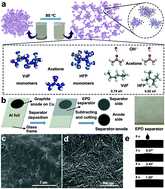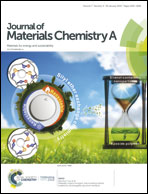Direct electrophoretic deposition of an ultra-strong separator on an anode in a surfactant-free colloidal system for lithium ion batteries†
Abstract
A hierarchically laminated nanostructured PVdF–HFP membrane is deposited directly on a carbon anode through efficient, scalable electrophoretic deposition (EPD) in a surfactant-free colloidal system. Lithium ion batteries based on the separator–anode configuration have a well-structured microscopic interface with uniform, reinforced separator/electrode contact. The resulting separator enables a high ionic conductivity of 8.1 × 10−4 S cm−1, and exhibits a low thermal shrinkage of 3% after annealing at 160 °C for 5 h, a high isotropic mechanical strength (∼33 MPa) and an ultra-high ductility (∼450%). The battery with the separator–anode configuration delivers a discharge capacity of 370 mA h g−1 (99.5% of the theoretical capacity) at 0.1C, an excellent capacity retention of ∼100% after 300 cycles, and a pronounced rate capability of 270 mA h g−1 at 1C. This work opens up the opportunity to realize both reliable and high-capacity material platforms for next-generation lithium ion batteries.



 Please wait while we load your content...
Please wait while we load your content...